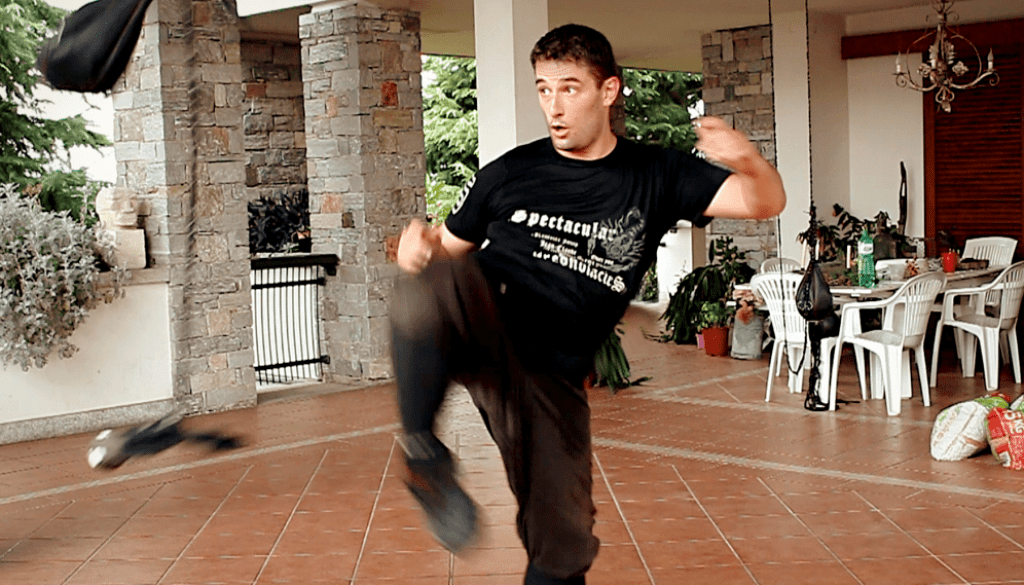Speed and quickness
What is the difference between speed and quickness?
Let’s start with a little disambiguation note to determine the difference between speed and quickness in terms of martial arts:
- Quickness – It is the time that our natural and “innate” body capabilities need to move our body (eg. we are quick if we can throw a punch in a short amount of time)
- Speed – It is that skill that comes from experience and allows us to execute effectively a combat technique (eg. we are fast if we can complete a technique, with precision, timing and without errors in a short amount of time)
In this way of seeing the velocity of execution, everyone can express quickness (eg. shaking a hand) but only a real fighter can manifest speed.
A note by Master Kongling – Quickness is relatively easy to reach, it’s a matter of muscular workout and it indeed useful and important but real speed means effectiveness, means to win the battle. Let’s be clear, speed is undoubtedly nourished by quickness, but it is not just that: to gain this kind of skill is a matter of years of hard and focused training (read Introduction to the idea of Precision Control).
Why this distinction is fundamental
As it is stupid to develop an incredible power without control, it is useless to be able to perform high-speed movements if, in the meantime, we make serious errors like:
- Dispersing energy (read Always be ready to fight: the body)
- Losing balance (read The concept of Dynamic Equilibrium)
- Losing control of the situation (read )
- Missing the target (read The most important skill in combat)
- Being completely uncoordinated
- Acting too early or too late
- Hurting ourselves
- Using the wrong technique
- Stopping us in unfavorable positions
- Allowing the opponent to use our inertia against us
- Being easily deceived
- …
Self-defense fighting (read The 6 types of martial clash) is not a sport and it does not happen in predetermined / protected / favorable contexts (read Martial art and self-defense: what are the differences?); we cannot expect:
- Time – To have the time to prepare ourselves to express the maximum performance
- Space – To have the right place to execute our moves without interferences or risks
- Respect – To automatically have a respectfully, honest, sympathetic (etc.) adversary
- Standards – To have a specific range of contexts of action and reaction
- …
We must be always ready to adapt ourselves to scenarios that we do not know and that we do not expect (environments, opponents type, number, personal conditions, etc.).
The correct way to gain speed of execution
When we study a technique (but even while we train with a new exercise) we must follow this order of interiorization (read The best way to study technique: 10 tips):
- Acquire the movement with patience (by trial and error)
- Eliminate the deficiencies
- Gain speed
- Gain power
- Combine everything effectively
- Apply it with gradually less collaborative partners
- Customize the technique to our body and mindset
- …
Let’s never forget that attitude is a choice, not a heaven’s gift.
Video
In-depth articles
- A scheme to quickly learn any kind of technique – A simple but effective method to interiorize any kind of techniques
- 4 Tips to effectively apply any fighting technique – The principles without which (in combat) any technique will fail
Questions
Reply in the comments and share your experience:
- Can you make an example of speed and quickness?
Author: Master Kongling
Founder of 6 Dragons Kung Fu.
How to master 6 Dragons Kung Fu?
Are you searching for:
- Daily training exercises?
- Synthetic theory and concepts?
- A step by step path from white to black belt?
- A path (clear, consequential and gradual) designed to build real martial skills?
- A direct contact with Master Kongling?
Go to our Patreon page and choose a training plan: starting from the Practitioner level, you will gain access to all this and much more.
Inside each Premium Lesson, you will receive the same teaching (practices, tips, concepts, small secrets and corrections) reserved to the live students of Master Kongling.
Important - Once a certain number of registrations are reached, no other participants can be accepted. For more information write to: [email protected].










February 28, 2019 @ 2:04 pm
Do muscles mass stop speed?
June 20, 2023 @ 6:46 pm
Love this
June 30, 2023 @ 2:40 am
😉
June 26, 2023 @ 2:33 am
Thanks.
June 30, 2023 @ 12:34 am
😉
December 22, 2023 @ 4:15 am
Hi i would like to do more exams and more skills
December 22, 2023 @ 11:06 am
2 things:
1) Before asking to do an exam you have to be prepared to address it, otherwise you just waste money and time.
2) The first skill to acquire in our school is the basic self-discipline of daily training (in the beginning it doesn’t matter for how long, even 5 minutes are good, every big journey starts with a single step).
February 4, 2024 @ 2:00 am
Good mterial
February 4, 2024 @ 9:25 am
😉